Menu
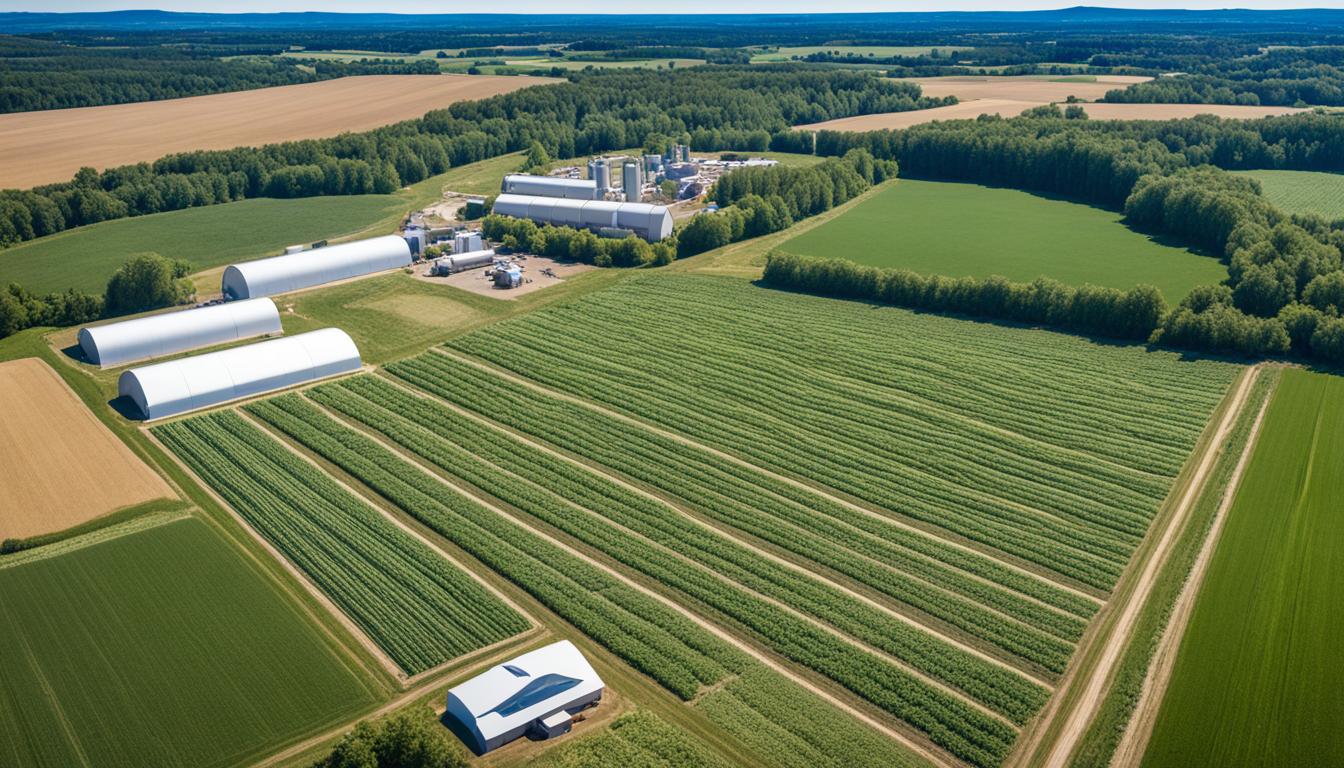
Did you know one-third of food for humans globally, around 1.3 billion metric tons, is lost or wasted each year? This big fact shows the need for circular agriculture. It means making a big change in how we farm. This change aims to use resources better, make less waste, and build a food system that lasts.
With more people needing food and materials worldwide, circular agriculture is a hopeful option. It improves the health of the soil, encourages a variety of life, and cuts down the use of chemicals. It follows the beliefs of regenerative farming. This is about using resources in a way that keeps everything going, much like a cycle. Circular agriculture helps solve many farming problems and keeps our food system strong. It’s also about farming in a way that’s good for the Earth and our future.
Today, the need for sustainable farming is more crucial than ever. As the world needs more food and fibre, circular agriculture steps in. It focuses on cutting waste, reusing what we have, and recycling. This makes our food system stronger and better for the earth.
Circular farming is all about reducing waste. It uses smart techniques to use resources better and create less rubbish. For example, farmers can grow different crops in a sequence, turn leftovers into compost, and manage pests naturally. These not only keep the soil healthy but also lessen the use of harmful chemicals. They are big steps towards a cleaner, greener farming.
Conserving resources is a key outcome. Thanks to these methods, farms can become more efficient and waste less.
Another big part is reusing and recycling in farming. It’s about keeping everything in use, and nothing goes to waste. For instance, turning food scraps into compost or old crops into animal feed makes farms more resourceful. This way, we get the most out of what we already have.
Plus, new tech like blockchain makes it easier to know where products come from. This helps make sure we’re sourcing resources wisely. When we use technology and smart farming together, we move towards a future where farming is kinder to the planet and more productive.
Around the world, experts from universities, companies, and governments are working together. They aim to constantly improve how we can farm in sustainable ways. By sticking to these ideas, we can make agriculture more eco-friendly. This matches the big picture vision of circular economy principles.
Circular agriculture offers big wins for both the planet and farmers’ pockets. It leads to a greener way of farming that brings many benefits.
One of its big achievements is lowering waste by reusing nutrients. This simple act has cut down the world’s greenhouse gas emissions by 31%. Plus, it helps plants, helping the environment in many ways.
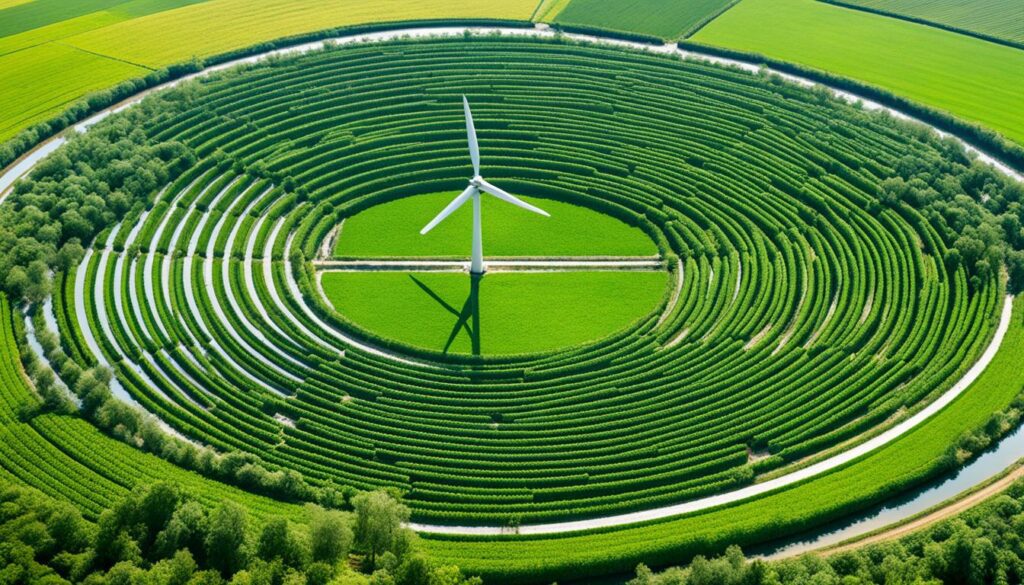
It’s also good news for the soil. Using fewer chemicals means the soil and water are cleaner. Imagine, in Europe, chemical fertilisers could drop by 80%, just by going circular!
Looking at the money side, circular agriculture cuts waste and chemical costs. This helps farmers sell their produce to people who care about the Earth.
It’s a bonus for smaller farmers. By embracing these smart farming ways, they can make more money. And it’s easier for all of us to buy healthy food.
About a quarter of global soils have been degraded, affecting an area nearly the size of India and the Russian Federation combined. Circular agriculture can significantly mitigate this issue by fostering regenerative practices that enhance soil health and biodiversity, making it an essential strategy for sustainable farming’s future.
Changing to circular agriculture means using sustainable farming methods. A key step is to use green farming techniques. This includes growing different crops to keep soil healthy and make plants stronger against diseases and pests. Rotating crops and planting cover crops help use nutrients better and protect different plant and animal species.
High-tech farming, known as precision agriculture, is also important. Farmers now use data and sensors to smartly use water, fertilisers, and protect crops. Adding solar panels and wind power to farms helps reduce pollution and leads to less use of oil.
“About one-third of the food made for us gets lost or thrown away every year. That’s 1.3 billion metric tonnes of food.” This shocking fact shows we must use circular agriculture to cut down on wasted food.
Composting is another key method. It’s good for the planet because it makes soil richer while reusing food scraps. By creating rich ecosystems, like planting trees with crops, we help nature and our farms are better prepared for changes in the climate. Circular farming not only benefits the environment but also brings new jobs and boosts the local economy.
| Sustainable Farming Method | Benefit |
|---|---|
| Crop Diversification | Improves soil health and pest resistance |
| Water Conservation Techniques | Reduces water wastage and promotes sustainability |
| Biological Pest Control | Minimises chemical use and promotes safe food production |
| Precision Agriculture | Optimises resource use through data-driven decisions |
| Renewable Energy Integration | Reduces carbon footprint and reliance on fossil fuels |
| Composting | Boosts soil health and reduces waste |
It’s crucial to adopt these sustainable farming methods for circular agriculture. They safeguard the environment, encourage green farming techniques, and help build a farming future that is both sustainable and robust.
Regenerative agriculture changes how we farm, putting soil health and biodiversity first. It aims to stop environmental damage, trap carbon, and support a natural farming. This method helps soil become richer and more resilient. It’s key in fighting climate change and boosting crop growth.
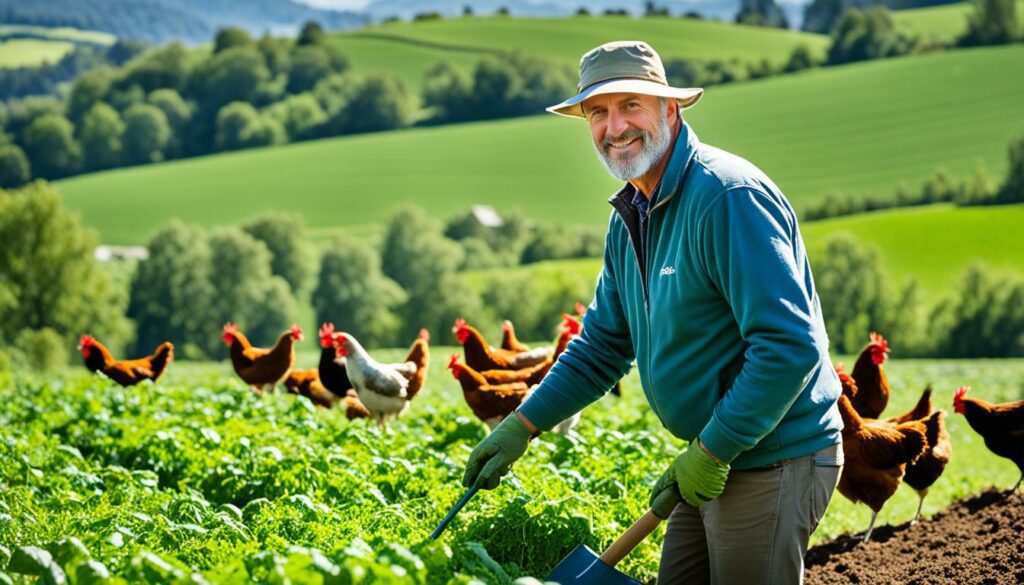
Agroforestry is at the heart of regenerative farming. It means planting trees on farms. Doing this makes the soil more fertile and supports more plant and animal life. Cover crops and holistic management are also vital. They help keep the ecosystem strong and lasting.
Fixing soil health has huge benefits. Better soil means more nutrients, water, and life in the soil. The land then becomes more productive and can handle tough weather like droughts and floods. The table below shows some advantages of regenerative agriculture:
| Benefit | Description |
|---|---|
| Carbon Sequestration | Reducing greenhouse gases by capturing carbon in the soil. |
| Soil Restoration | Rebuilding organic matter and enhancing soil structure. |
| Biodiversity | Increasing plant and animal variety on farms through techniques like agroforestry. |
| Climate Resilience | Improving the land’s ability to cope with climate fluctuations. |
Regenerative agriculture is more than a farming method. It’s vital for the earth’s future. By restoring the soil and using diverse farming ways, we ensure a lasting future for agriculture.
Closed-loop agriculture is a leading technique in the circular farming economy. It reuses outputs like manure for fertilisers. This reduces waste and promotes sustainable food production.
By 2050, we’ll need to feed 10 billion people. But, the amount of farmable land is decreasing. Closed-loop systems help overcome this challenge. They make better use of resources and increase yields.
Every year, the world throws away one third of its food. Closed-loop systems cut this waste by recycling what’s left. They make food production processes more sustainable.
These systems are also making a big difference in how we water plants. They’re improving crop growth and saving water. This is crucial since most of our freshwater goes to farming.
More and more, groups are working together on closed-loop farming. In projects like Plant Chicago, they turn farm waste into useful things. This builds a circular economy and a stronger sense of community.
New farming technologies are boosting the benefits of closed-loop systems. Precision farming cuts down on resources. Vertical farming uses less space but grows more food.
Another innovation is biochar, which cleans up water used on farms. It’s good for crops and the environment. This shows how complete the circle can be in farming.
Even in cities, closed-loop systems can provide fresh and sustainable food. They are good for the environment and tackle climate change. We can grow food efficiently and protect the planet.
Closed-loop farming can also save money for farmers. By lessening the need for expensive fertilisers, it boosts self-reliance. This makes agriculture more sustainable and strong.
Looking ahead, these systems are vital for the planet’s health. They recycle nutrients and protect future food supplies. We ensure farms are productive and our ecosystems healthy.
| Aspect | Benefits | Examples |
|---|---|---|
| Waste Reduction | Minimises waste, enhances sustainability | Using manure as fertiliser |
| Resource Efficiency | Optimises resource use | Precision agriculture tools |
| Water Conservation | Improves water usage efficiency | Closed-loop irrigation systems |
| Economic Resilience | Reduces costs, enhances self-sufficiency | Plant Chicago project |
| Climate Impact | Mitigates global climate change | Reduced greenhouse gas emissions |
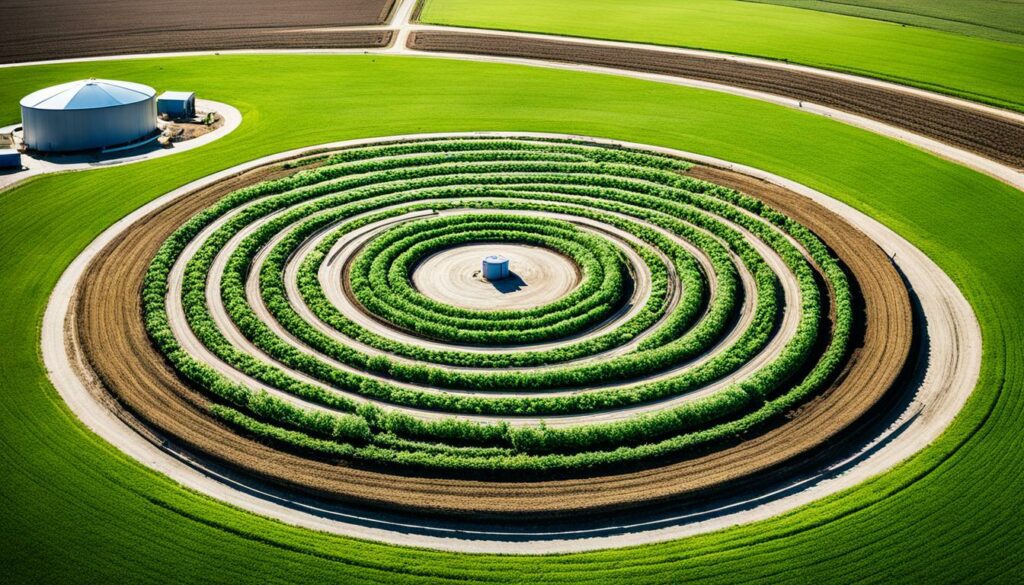
Looking into zero waste agriculture, I am amazed by the focus on no wastage. This method fits well with circular agriculture. It also pushes the idea of real sustainable farming.
In waste-free farming, all by-products join the farm again. For example, composting turns organic waste into fertiliser. This cuts the use of chemicals. In zero waste farming, we save over 90% of waste by reusing and recycling.
Dr. Bronner’s works with Serendipalm in a “plastic insetting” scheme in Ghana. This effort shows Dr. Bronner’s aim for complete sustainable agricultural practices. They have been a leader since 2003, introducing 100% recycled plastic bottles.
Using green manure and crop waste for bioenergy helps reach zero waste goals. This makes farming less harmful to the environment. It also supports the idea of circular farming.
Products like The Soap Refill Carton and Refill Stations are making a big difference. They use less plastic and stop the use of single-use bottles. The Soap Refill Carton plans to cut plastic use by 90%, showing the need for constant innovation in waste reduction.
Sustainable farming’s effects go far. For every dollar spent on food, we pay two dollars in other costs. Half of these are from how food is grown. Bad farming practices add to pollution and costs. This shows why we need farming without waste to reduce harm.
| Practices | Impact |
|---|---|
| Composting | Reduces chemical fertiliser use |
| Plastic ‘insetting’ programmes | Facilitates waste collection and recycling |
| Bioenergy from crop residues | Limits environmental strain |
| Refill initiatives | Decreases single-use plastic dependency |
By using zero waste farming, we build a better future. Reusing waste makes the environment healthier. It also helps those to come after us to live well.
Holistic agriculture uses a whole system to build a farm that is self-sustaining and kind to the planet. It pays attention to the many ways things on a farm work together. This helps make better use of resources and keeps the farm going strong for the future.
It uses methods like cover crops and changing which crops are grown each year. Adding natural materials to the soil also helps. Together, these practices make the farm’s land healthier. They make the soil richer and bring more kinds of plants and animals to the area.
Farm animals and crops work together in holistic farming. For example, using cows or chickens can offer many good points. Manure feeds the soil, animals eat leftover plant bits, and bugs that harm the crops are kept in check. This approach boosts the farm’s natural balance and keeps the soil full of life.
Keeping the soil healthy is at the heart of holistic farming. Farming in a way that encourages many types of life helps the land fight off troubles and handle changes better. Working with nature this way builds a solid way to keep growing food, even with big environmental problems around.
| Study | Crop Yields | Soil Quality | Greenhouse Gas Emissions |
|---|---|---|---|
| Das et al., 2017 (India) | Increased | Improved | – |
| Chen et al., 2019 (China) | – | Improved | Reduced |
| Chiriacò et al., 2017 (Italy) | – | – | Lower |
| Zhou et al., 2019 (China) | – | – | 13.4% Reduction |
Eco-friendly farming is now at the forefront of sustainable crop production. It often aims to reduce environmental harm. But, it also ensures farms remain productive.
Organic farming is a key part of eco-friendly systems. It doesn’t use synthetic fertilisers or pesticides. This brings about healthier soils and ecosystems. It boosts biodiversity in farmland, which helps keep nature in balance.
Other practices like crop rotation and composting also help. These enrich soil and lower the need for man-made materials. This means more sustainable farming.
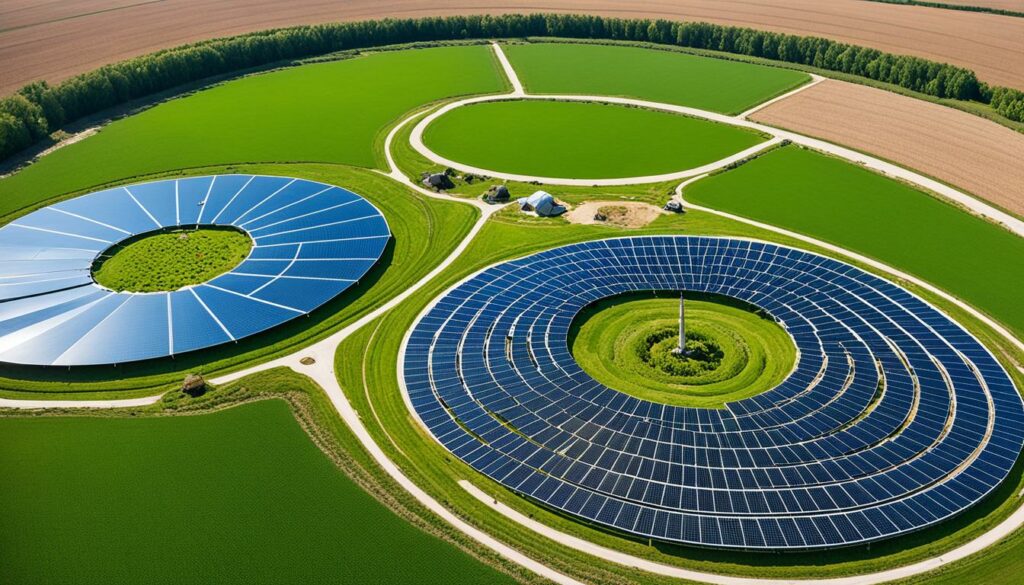
Agroforestry is particularly effective in being eco-friendly. It mixes trees with crops and animals. This comes with a host of benefits. Such as, saving resources, stopping soil erosion, and boosting plant and animal variety. Trees do things like block the wind, help save water, and give homes to different creatures.
This improves farming areas’ abilities to cope with changes. Plus, it helps fight climate change by storing more carbon.
Experts believe that using organic farming and agroforestry together is key. They help create farming that can last. This way of farming fits well with the philosophy of circular agriculture.
Agroecology and circular agriculture come together to build a green and effective way to grow our food. They both focus on looking after our planet and using what we have well. Agroecology uses nature’s own systems to grow food. It helps by reusing nutrients and by letting different plants and animals help each other out.
One big win for these methods is cutting down on the food that’s thrown away. It’s shocking that almost a third of the food we make doesn’t get eaten. This waste uses up a lot of energy and doesn’t make our food supply safer. By combining agroecology and circular farming, we hope to use resources better. This can lower the greenhouse gases that come from wasted food, which is a huge problem.
In the Congo Basin, a special project is showing how this can make a real difference. It helps farmers use better, more eco-friendly methods. And in February 2020, people from nearly 30 countries got together to talk about it. This shows that around the world, there’s a strong interest in using these ways of farming more.
In our cities, we’re not very good at reusing the nutrients in our food. But more and more of us are living in cities. By 2050, many believe almost 70% of the world’s people will live in urban areas. Efficient and green farming in cities is key to the future. It helps us use less money and land for farming. This is important as farming costs the world a lot every year.
Agroecology and circular agriculture are not just about saving money. They are about making sure we can always grow enough food. When we farm in a way that doesn’t harm nature, we make our food system strong. This is good for the planet and for everyone who lives on it.
By joining agroecology and circular farming, we’re paving the way for a brighter future. It looks at food and the environment as one big system. And with everyone working together, it’s a hopeful start for the things to come.
Permaculture is about designing with nature. It’s like being inspired by how natural systems work. It encourages using what we have locally and wisely. This creates farms that are strong and good for the planet.
It focuses on farming that keeps the soil and living things healthy. By doing this, it stops huge parts of land turning to waste each year. This is as big as Zimbabwe. Also, permaculture helps use less water from rivers and lakes, which is great for the whole world.
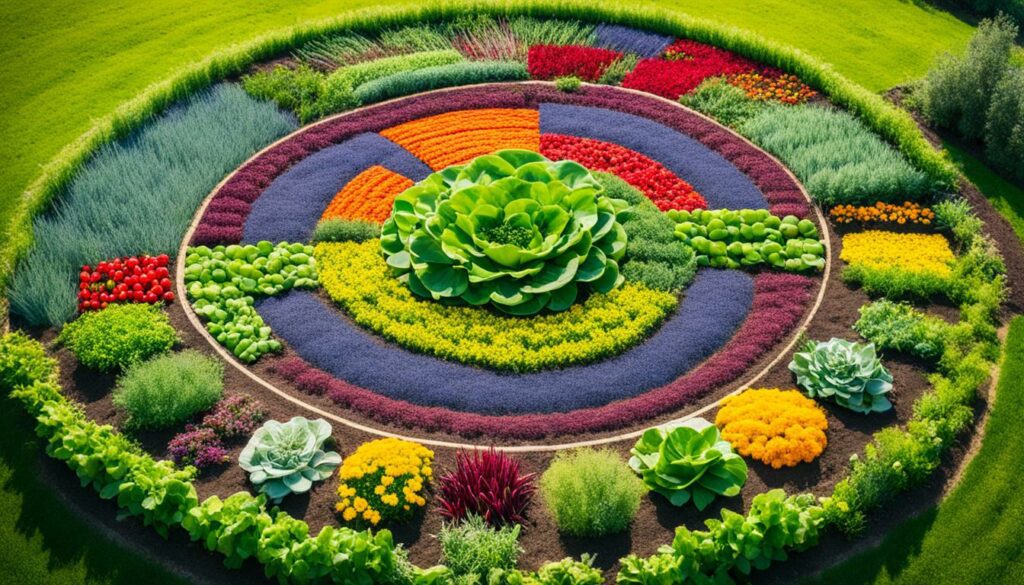
Our current way of making and throwing away food is very wasteful. An amazing amount, like six huge trucks, is lost every second. But, permaculture can change this. It offers ways to keep using food and its parts in smart ways. This can save lots of money and help the planet and health too.
We really need to start using permaculture and eco-farming more. Think ahead to 2050 when most people will live in cities and use a lot of food. We need to find ways to get back food that’s thrown away. Now, almost none of it gets used again. This is super important to keep people and the planet healthy, and safe from bad chemicals in our food. This could save about 5 million lives each year.
Studies from all over the globe show that circular agriculture works well. It’s not just good for the earth but also makes life better for people. Places like China and Kenya have seen great benefits from this kind of farming.
Taking on permaculture is key to better farming for the future. It’s not just a new way, but a way that promises a healthier world. It can help our farms and food last longer, not just for now but for our children too.
| Statistic | Impact |
|---|---|
| Annual health, environmental, and economic costs of food production | USD 5.7 trillion |
| Soil degradation globally each year | 39 million hectares |
| Percentage of global freshwater used in intensive agriculture | 70% |
| Food waste per second | Six garbage trucks |
| Projected urban population by 2050 | 68% |
| Projected urban food consumption by 2050 | 80% |
| Nutrient recovery from food by-products and human waste in cities | Less than 2% |
Engaging and educating consumers is key to moving towards circular agriculture. A blog post on circular agriculture got around 87 views. This shows how vital it is to educate consumers about sustainable farm products.
Consumers influence market demand by choosing eco-friendly products. When consumers know the impact of their choices, they tend to pick green options. This change in what consumers want causes big shifts in farming.
First, we need to make people aware of the benefits of circular agriculture. Technologies like blockchain help to show where our food comes from. This way, consumers can pick what’s best for the planet.
Various groups work together to find new solutions for farming. They help spread the word about green choices. This teamwork is important in educating the public.
Encouraging green actions goes beyond just talking about it. We must show people how simple farming changes are good for the Earth. Things like rotating crops and using pests in a smart way are good examples.
Studies show that what we buy affects how much green farming grows. Teaching people about green businesses in food makes them more open to these ideas.
| Aspect | Traditional Agriculture | Circular Agriculture |
|---|---|---|
| Resource Utilisation | Linear use with high waste | Efficient use with recycling |
| Consumer Role | Passive recipients | Active participants |
| Environmental Impact | High emissions and pollution | Reduced environmental footprint |
In summary, educating people and encouraging green choices can lead to a life focused on the Earth. This helps both nature and the farming business to survive. As people learn more about circular farming, their choices will help create a greener food system.
The use of new technologies is key to advancing circular agriculture. These tools help in better farming methods. 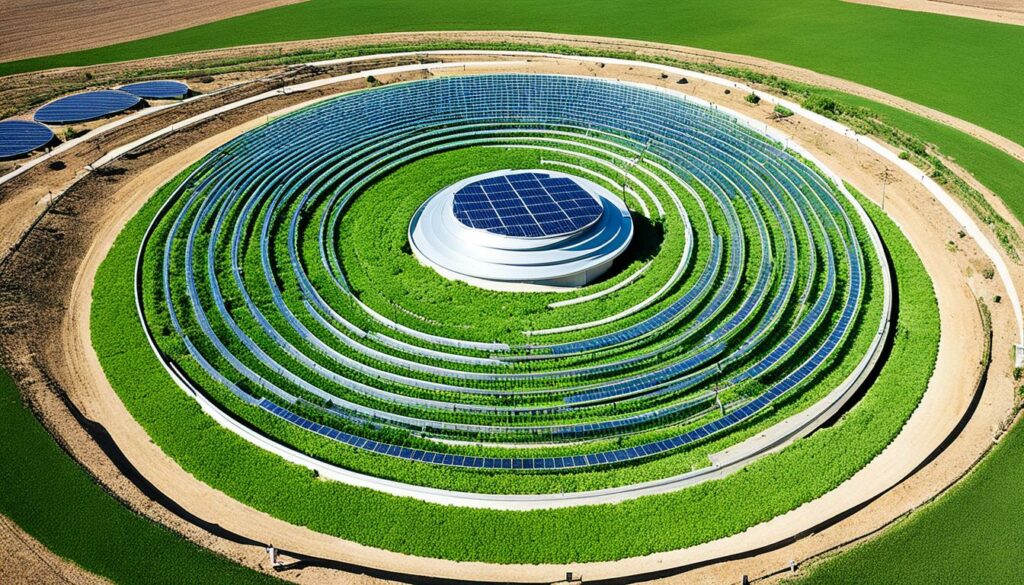
Precision agriculture is leading the way in new farm techniques. It uses data and tech to make farm actions more exact. This means things like using GPS to find the best places to plant or using sensors to see which crops need more water.
By being more accurate, farmers can use resources better, make less waste, and get more crops. Thanks to AI, farming is even smarter. It can put water, fertilisers, and pesticides just where they’re needed. This cuts down on waste and is better for the planet.
Biotechnology is a big part of making farming greener. It helps by creating plants that are strong against hardships without the need for lots of chemicals. Companies like Unibaio are making small particles. These particles help pesticides and fertilisers work better without harming the environment. This shows how important biotechnology is for making farming more eco-friendly.
Using renewable energy fits perfectly into circular farming’s goals. It means using solar, wind, and bioenergy to power farms. This way, farms can use less energy that’s not good for the planet.
The International Renewable Energy Agency (IRENA) says renewable energy is growing fast. In 2022, there was a 9.6% jump in how much farms use renewable energy. This change is great for the environment and the farm’s budget.
These new technologies are making circular farming more efficient and green. The market for agricultural technology could double by 2030. This growth shows just how much these innovations matter for farming’s future.
From around the world, we see many success stories in circular agriculture. These show different ways to farm sustainably. They teach us a lot about using nature wisely for farming.
The Ellen MacArthur Foundation has brought attention to key cases. These show how farming can help the planet. With Charity Registration No.: 1130306 (OSCR Registration No.: SC043120, and Company No.: 6897785), their studies cover areas like nature, buildings, weather, food, and more.
Some interesting examples include:
These projects come from places like Africa, Asia, North America, and Oceania. They’re great examples for those wanting to farm in a greener way. Each one shows a special method for being kind to the Earth while farming.
This movement is growing. It’s changing how we farm and eat for the better. These projects are key in learning and inventing new ways to make agriculture sustainable for everyone.
Moving towards circular agriculture is vital for green farming. It faces hurdles like high start-up costs, policy changes, and a lack of education. Tackling these issues means looking at the costs to start, changing rules, and teaching farmers new methods.
Starting circular agriculture requires a big money input. Farming in a circular way needs new buildings, tools, and tech which can cost a lot. But, these spends can bring savings and make farming more efficient. For example, starting a closed-loop system helps lower the use of chemical fertilisers. It also makes better use of waste. This change is costly but the money saved over time and the healthier soil make it worthwhile.
Having good laws and policies in place is essential for circular farming to take off. These should encourage eco-friendly methods and help farmers financially. In places like Europe, policies supporting circular food systems aim to cut down chemical fertiliser use by a lot. Good rules also ensure farmers meet green standards and keep progressing towards a sustainable future.
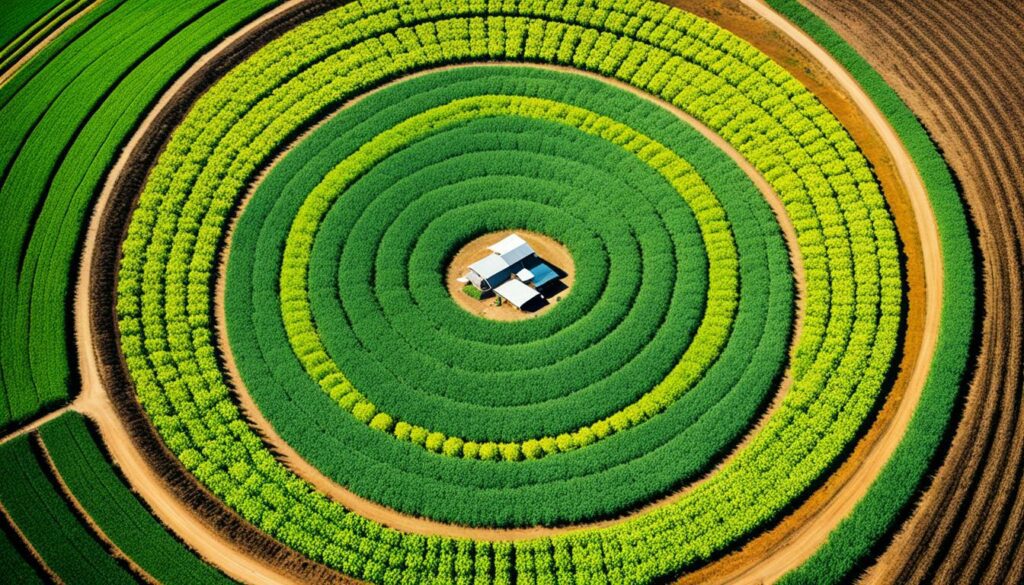
One big problem faced in green farming is not knowing enough about how to do it. It’s key to teach farmers and those involved about circular farming. This includes lessons on how to farm without harming the environment and how closed-loop farming works. This way, we make sure everyone knows how to make farming better for our planet.
Moving to circular agriculture means we invest in tomorrow. Even though the obstacles are tough, with the right laws and education, we can make it. This will create a farming sector that bounces back well and cares for the Earth.
The future of farming is getting brighter with circular agriculture. It offers a way for the farming sector to thrive sustainably. This method focuses on minimal waste, recycling of materials, and new agricultural innovations for a greener future.
Based on policy changes, circular agriculture got a boost in September 2018. Dutch Minister Carola Schouten made it a top goal. The idea is to reduce production loss to the lowest. With lots of livestock in the Netherlands, circular farming handles extra manure and less minerals in soils. New technologies like biotechnology help make farming more efficient and friendly to the environment.
Going circular slashes waste and increases farm output. Reports from places like Wageningen UR show that waste could drop by 20-30%. And, farms might produce 15-20% more. This shows that circular agriculture is good for the earth and the wallet.
By using resources again in farming, biodiversity can thrive. Circular farming can make crops 40% more resilient to pests and other problems. And, better water use can save 30-50% more water. This shows that circular agriculture is key to future farming.
Using renewable energy is important for circular farming. This step could cut carbon emissions and keep farms more green. Eating local food reduces greenhouse gases from food transport by 25-35%. It shows the good of eating locally.
But, circular agriculture faces some challenges with laws and practices. We need to work on letting farms use fewer outside resources. But, with more people wanting eco-friendly food, there could soon be a 10-15% rise in demand. This is a good sign for the future. It shows that innovation will lead to changes in agriculture. Circular farming is set to become crucial for the global food system in the long run.
| Aspect | Projected Improvement |
|---|---|
| Waste Generation | 20-30% Reduction |
| Farm Output | 15-20% Increase |
| Crop Resilience | Up to 40% Improvement |
| Water Savings | 30-50% Increase |
| Energy Usage | 30-40% Reduction |
| Emissions from Food Transport | 25-35% Reduction |
Hence, looking forward in farming means choosing circular agriculture. It promises a full and smart way to protect our planet’s resources for the future.
Circular agriculture is changing the way we farm today. It balances the need for more food with protecting our environment. About half of the habitable land on Earth is already used for farming. This makes the “reduce, reuse, and recycle” thinking very important. It helps with big environmental and money issues farming faces worldwide.
This farming technique has already shown some impressive results in Europe. For instance, it’s reduced the use of chemical fertilizers by 80%. Since 1961, global use of fertilizers has gone from 12 million to over 110 million tonnes. Key circular methods include crop rotation, composting, and agroforestry. These not only cut waste but also make soil better and help ecosystems thrive. Agriculture generates about 31% of the world’s greenhouse gases. So, by using circular farming, we could really make a dent in climate change.
Circular agriculture also helps with jobs and money. It sets up a circular economy around farm waste. This creates new jobs and fosters economic growth. By using new tech and waste reduction methods, our food system becomes stronger and better for the next generations. This path to circular farming supports a greener way of farming. It looks after our Earth and makes sure we have enough food in the future.
Circular agriculture is a way of farming that reduces harm to the environment. It does this by using resources well, creating less waste, and recycling. The aim is to make farms more sustainable by caring for the soil, encouraging a variety of life, and cutting down on harmful chemicals.
Circular agriculture tackles waste by doing things like changing what crops are grown, making compost, and managing pests in a more natural way. These practices make the soil healthier, reduce the need for chemicals, and save resources. This all helps cut down on wasted food.
The big wins for the environment with circular agriculture are less waste, richer nature, and a drop in harmful chemicals. By using up resources better, farming’s harm to the world is reduced. This boost both the future health of the planet and the strength of farms.
Making farming more long-lasting in circular agriculture involves mixing up what’s grown, saving water, and controlling pests without poisons. Using new technology and turning to renewable power also helps these ways stick, making farming stronger and greener.
Regenerative farming looks to fix up poor soils and trap more carbon from the air. It uses things like growing trees among crops and managing farms in a more complete way. This can make farms more ready for climate issues while growing more food.
A closed-loop way of farming means farming in a cycle where waste feeds into new growth. The idea is to cut waste and use things over and over. This captures the heart of circular agriculture, making farming more able to feed itself and keep going.
Zero waste farming aims to ditch waste from farm work. Things like making compost from leftovers, planting ‘green’ plants to feed the soil, and using parts of plants for energy all help. This pushes farming to be greener and matches up with circular farming’s idea of using all we can.
Holistic farming boosts the soil and life by mixing crops with farm animals. This all works in a way where everything supports each other. It’s farming that’s like a living system, making the earth stronger and the land better for growing.
Ways that are kind to the earth include farming organically and planting trees alongside crops. Organic farming avoids harmful chemicals, letting nature balance itself. Having trees mixed with crops keeps the land healthy, stops soil from running off, and attracts various forms of life, all key to circular farming.
Agroecology is a set of ideas like using wastes to grow more, making the most of energy, and mixing lots of plants and animals. These ideas fit well with circular farming’s goals to look after the earth and use things smartly. Together, they help make farms that can stand up to changes and keep growing food well.
Permaculture is about designing farms that feed themselves and last a long time. It looks to nature for how to do this and uses local stuff as much as it can. This is much like circular farming, both wanting farms that are strong, stay green, and take care of themselves.
People can change farming by picking food that’s good for the planet. Choosing local and fresh food and not wasting it at home can really help. This pushes farms to be greener and meet the growing need for more earth-friendly food.
New tech is a big part of making farming circular. Tools that fit farming to the smallest detail, using biology smartly, and making energy from clean sources, all cut down on waste and cut out the bad ways. This makes farming both more modern and better for the earth.
Stories from worldwide show how circular farming works well in real life. These success cases teach us the best ways to farm that protect the earth. They are roadmaps to making farming sustainable and lasting.
Circular farming can be hard to start because it costs more and needs new ways of doing things. But with laws that help, smart policies, and everyone learning, we can get there. Overcoming these barriers is key to changing farming for the better.
Looking ahead, circular farming is set to grow thanks to new tech and the love for the planet. This means farming that’s both good for making food and for keeping our world healthy. It’s a big step towards farming that lasts for a long time.